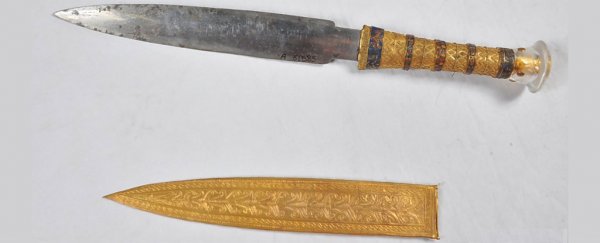King Tutankhamun is one of the most recognisable historic figures from ancient Egypt, mainly due to the fact that he was a boy king who mysteriously died - likely from a broken leg - at age 19 after a 10-year rule as pharaoh.
Oh, and there's the whole cursed tomb thing, which supposedly killed George Herbert, the man who first entered King Tut's tomb back in 1922, though now his death has been attributed to blood poisoning brought on by a mosquito bite (thanks for wrapping that one up, science).
All of these stories - plus his ornate sarcophagus and mysterious tomb - have led to King Tut having a chokehold on our collective imaginations for centuries, with no signs of stopping. And now, a new discovery is adding more fuel to that fire, because researchers say the boy king was buried with a dagger made from meteoric iron.
Yes, as if alien conspiracy theorists needed anything else to go on, a joint team of researchers from Italy and Egypt say they've found evidence that suggests King Tut's fabled golden dagger, which was buried entombed with him in his sarcophagus, is actually a space dagger made from a meteorite, mostly composed of iron and nickel.
The blade was originally described by Howard Carter in 1925 as "a highly ornamented gold dagger with crystal knob", reports Rossella Lorenzi for Discovery News. A better description would be that the dagger is made from iron with a golden handle and sheath, both of which are covered with highly detailed patterns. It's pretty much exactly what you'd expect an ancient Egyptian dagger to look like.
The team was able to study the blade's composition by using non-invasive X-ray fluorescence spectrometry - a technique that allows scientists to pretty much look 'inside' any object.
After the scan, the team found that the blade is composed of 11 percent nickel - much higher than traditional iron blades that contain roughly 4 percent nickel on average. This suggests that the iron originated from a meteor, because they tend to contain more nickel than iron sourced from Earth.
"Meteoric iron is clearly indicated by the presence of a high percentages of nickel," team leader Daniela Comelli from Milan Polytechnic in Italy told Discovery News. "The nickel and cobalt ratio in the dagger blade is consistent with that of iron meteorites that have preserved the primitive chondritic ratio during planetary differentiation in the early solar system."
Next, the team set out to find the actual meteor that the blade might have been made from. To pull this off, they investigated every meteor site around the area.
"We took into consideration all meteorites found within an area of 2,000 km in radius centred in the Red Sea, and we ended up with 20 iron meteorites," Comelli said. "Only one, named Kharga, turned out to have nickel and cobalt contents which are possibly consistent with the composition of the blade."
Kharga, according to Lorenzi, was found back in 2000 at a seaport west of Alexandria, which makes it a prime candidate for use in the boy king's dagger. Just think about this discovery for a second. The team was able to not only figure out that an ancient dagger was probably made from a meteor, but also what meteor that iron came from. That's insane.
What's even cooler is that the space dagger isn't even the first otherworldly artefact found in Tutankhamen's tomb. His necklace, which was previously thought to be made from chalcedony - a type of quartz - is actually made of Libyan desert silica glass.
This type of glass forms when a meteor hits sand, for example, the sand of the Great Sand Sea of Egypt - an area that lies roughly 804 km (500 miles) away from where ancient Egyptians called home, Lorenzi reports. While no one is sure exactly why meteor materials were beloved at this time, it's likely that Egyptians thought meteoric iron was a divine substance, since it fell from the heavens.
The dagger's discovery predates the start of the Iron Age by about 100 years. And since it's constructed so well, researchers say its existence hints at the fact that ancient Egyptians had an understanding of iron long before the rest of humanity did.
Besides the dagger, King Tut's tomb may hold other secrets, such the tomb of Queen Nefertiti, which might lie behind the tomb's walls, though researchers are still investigating the hypothesis by scanning the tomb in much the same way that the space dagger team did.
The space dagger shows that there are many more discoveries waiting for researchers in Egypt, despite the area's incredible popularity. The hope is that as our technologies improve, so will our ability to look inside ancient objects without damaging them, allowing us to see things that we would have previously missed.
We can't wait to see what they find next.
The team's findings were published in the journal Meteoritics and Planetary Science.
